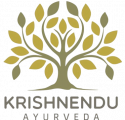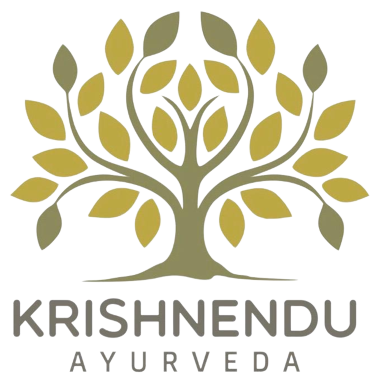Blog
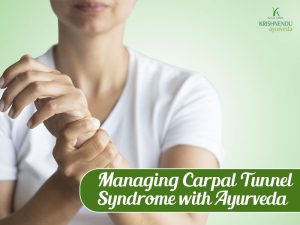
Managing Carpal Tunnel Syndrome With Ayurveda
Carpal Tunnel Syndrome, also called as CTS, causes pain in the wrist which is due to the pressure on the median nerve in the wrist. Carpals are the bones that constitute the wrist and the carpal tunnel is a narrow passageway made of bones and connective tissue on the inside of the palm. The median nerve is one of the 5 main nerves which extends from the lower part of the neck and controls the movement and sensation of the muscles of arm, forearm and hand. The condition of CTS occurs when the median nerve is compressed due to the narrowing of the carpal tunnel which may be due to swelling or degeneration of the tendons passing through it. Symptoms of Carpal Tunnel Syndrome Wrist pain that may extends to elbows or shoulder Tingling, numbness or weakness in all finger except the little finger Reduced finger coordination and movement Increased pain at night Muscular weakness Risk factors for CTS Wrist fracture Overuse of wrist joint when using computer or playing piano, etc. Some diseases like rheumatoid arthritis, high blood pressure, diabetes, obesity, thyroid issues, kidney problems, etc. Ayurvedic Management of Carpal Tunnel Syndrome Ayurveda regards the vitiation of Vata to be the root cause of conditions with characteristics like pain, numbness etc. And hence, the Ayurvedic management of CTS aims to address the vitiated Vata dosha through a holistic approach with therapies, medications, lifestyle recommendations, yoga and exercises. Ayurvedic therapies recommended for the condition, Abhyanga – Ayurvedic massage with medicated oils help relieve pain, numbness and tingling sensation, while also providing a soothing effect. Swedana – Fomentation or sweating using medicated vapours is recommended for managing the condition with Vata and Kapha involved. Patra Pinda Sweda and Shashtika Shali Pinda Sweda are also advised for managing Vata symptoms like pain and numbness. Churna Pinda Sweda – Fomentation using boluses of herbal powders are performed when Kapha symptoms like stiffness and swelling are predominant. Dhara – Different types of the therapy which include Kashaya Dhara, Taila Dhara Organic Essential Oils and Dhanyamala Dhara are advised for Vata and Kapha predominant symptoms. Greeva Vasti – The process of retaining medicated oils on the cervical spine is recommended for soothing the nerves whose branches control the upper limb including hands, wrist and fingers. Internal medications prescribed under consultation include, Oils or Taila – Ksheerabala taila, Mahanarayana taila, Maha Masha taila, etc. Herbal decoctions or Kashayam – Rasnaerandadi kashayam, maharasnadi kashayam, Punarnavadi kashayam, etc. Herbal fermented liquids or Arishtas – Ashwagandharishtam, Dhanwantararishtam, Punarnavasavam, etc.
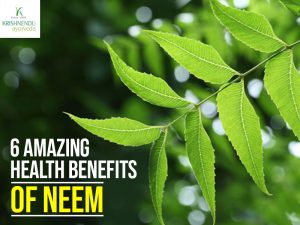



6 Amazing Health Benefits Of Neem
Neem is considered as a powerful Ayurvedic herb due to its healing properties and a wide range of health benefits. Ayurveda regards neem to possess bitter taste, cooling energy, dry and light qualities and as effective for reducing Pitta and Kapha doshas. It is highly-regarded for its cleansing, anti-bacterial and anti-inflammatory properties. Below listed are some of the amazing health benefits offered by Neem. 1. Skin health The anti-bacterial properties and cooling effect of neem is recommended for healthy skin and for a clear complexion. It helps reduce excess heat that manifests as blemishes and is also an excellent solution for acnes, pimples, rashes and other skin problems. The leaves, oil and powder of neem is used as various preventive and therapeutic herbal solutions for many common skin problems. 2. Immunity The detoxifying properties in neem makes it an immune-booster. It is also considered effective for cleansing accumulated ama from the body. Regular intake of neem capsules under prescription is advised for strengthening immunity. Neem tea is also considered effective to reduce fever. 3. Gastro-intestinal health Neem helps reduce the inflammation in the GI tract and also reduces ulcers. The herb is also considered to remove unwanted heat and toxins to promote digestive health. Neem leaf extracts are used in the making of Ayurvedic medicines for digestive problems and neem bark extracts is used to help reduce stomach acid levels. 4. Blood sugar Neem is also considered to optimize insulin receptor function and thus to ensure that the body is able to process appropriate amounts of insulin to prevent diabetes. Neem leaf extracts and neem seed oil are used to help regulate sugar levels. 5. Metabolism Due to its Kapha-reducing properties, neem promotes proper digestion and elimination of fat and water, while also preventing accumulation of toxins. Drinking neem juice on a regular basis is advised for maintaining a clean stomach and also to improve metabolism. 6. Oral health Neem is one of the common ingredients in oral health products due to its antibacterial properties which prevent tooth decay and strengthens the teeth. Chewing neem bark or using tooth powders with neem is a common method to ensure oral health.
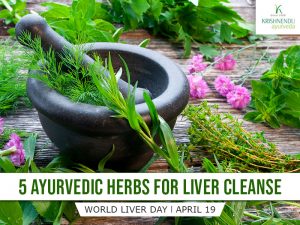



5 Ayurvedic Herbs For Liver Cleanse
Liver plays a vital role in digestion and metabolism. It also considered a primary organ of detoxification as it filters the blood and eliminates toxins from bloodstream as well as processes external compounds like medicines or alcohol. A liver cleanse ensures the optimum health of the organ and promotes proper elimination of toxins for health and longevity of the body. Here are 5 Auyurvedic herbs recommended to support a liver cleanse. 1. Bhumyamalaki – A classic Ayurvedic herb advised for liver support, its dry, light, bitter, cooling, soothing and cleansing properties help pacify Pitta and Kapha. It also helps cleanse, detoxify and strengthen the liver and the gallbladder. 2. Kutki – Its deep cleansing action has an effect on both liver and gallbladder and promotes healthy liver function and flow of bile. Considered a must-have liver tonic and blood cleanser, Kutki can also balance Pitta and Kapha, while supporting systematic immune function. 3. Guduchi – Guduchi is a powerful detox herb which shows antioxidant properties to help protect liver and kidneys. It is beneficial for cooling, calming and soothing vitiated Pitta, while also being a tri-doshic with equal benefits for Vata, Pitta and Kapha. 4. Amla – Rich in Vitamin C and antioxidants, Amla pacifies aggravated Pitta and helps eliminate excess hear from the digestive tract. It is also considered to support healthy liver cells. 5. Turmeric – Turmeric is highly beneficial for the skin, digestion, liver and brain. It possesses a detoxifying effect that is beneficial for the entire system while also supporting tissues and organs.
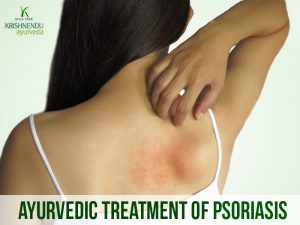



Ayurvedic Treatment Of Psoriasis
Psoriasis is an inflammatory condition of the skin that causes rapid skin cell production which results in reddish dry patches and scales on the skin. It is commonly seen on the elbows, knees, and scalp. Itching or burning sensation, blisters, discoloration of the skin, reduced sweating, etc. are some of the features of Psoriasis. Ayurveda refers to psoriasis as Ekakushta which is considered one of the 11 types of Kshudra Kushta which are curable minor skin diseases. And according to Ayurveda, the vitiation of Vata and Kapha doshas leads to the accumulation of toxins in the deep tissues of blood, flesh, nutrient plasma and lymphatic, which in turns causes the manifestation of skin lesions in the body. Causative factors of Psoriasis Excess consumption of contradictory foods like fish and dairy products together. Increases intake of sour and salty foods, yogurt, black gram, seafood, etc. Alcohol and tobacco consumption Irregular food habits Stress Hereditary factors Ayurvedic treatments for Psoriasis The primary line of Ayurvedic treatment for Psoriasis includes the purification of the blood and tissues. The body is cleansed of toxins and the metabolism is restored to prevent further accumulation of toxins. Medications are then administered to rejuvenate the tissues and to promote healing of the skin. Panchakarma The Ayurvedic purification and detoxification process of Panchakarma is advised for Psoriasis to detoxify the body and to balance the vitiated doshas. Vamana, the process of medicated emesis and Virechana, the purgation therapy are recommended to rid the body of toxins. Snehapanam Consumption of medicated ghee for a specific number of days is also advised for Psoriasis according to the type of dosha involved. Thakra Dhara The process of pouring medicated buttermilk on the forehead in a continuous stream is indicated for skin diseases like psoriasis. Karaskara Ksheera Dhara Pouring a warm herbal decoction prepared in milk in a continuous stream over the body is therapeutic to improve peripheral blood circulation and for reducing pain, numbness, burning sensation and inflammation. Karaskara Ksheera Dhara combined with specific oils for external oils is considered effective for psoriasis and eczema.




Ayurvedic Therapies For Back Pain
Back pain can be linked to various conditions of the spinal cord and nerves, discs between the vertebrae, ligaments surrounding the spine and discs, lumbar muscles and internal organs in the abdomen and pelvic area. It may also be indicative of Cervical Spondylosis, Lumbar Spondylosis, Ankylosing Spondylosis, Sciatica, spinal cord infections or tumours that compress the spine and nerve roots. The most common causes of pain in the lower back are mainly due to sedentary lifestyle, obesity, stress and strenuous physical work. Back pain in Ayurveda Back pain is referred to as Nitambha Shoola or Kati Shoola in Ayurveda and Vata predominance is regarded as the cause for it. Balancing vitiated Vata is considered important in the line of treatment of back pain. Ayurvedic therapies for back pain Ayurvedic treatment for back pain helps in correcting the imbalances of the body, which in turn nourishes and rejuvenates the body, boosts immunity, and also relaxes the mind. Some of the Ayurvedic therapies for back pain are: Kati Vasthi Luke warm medicated oil is retained on the lower back with the help of a circular receptacle made out of black gram dough in this therapy. The process helps relieve pain, stiffness and degenerative issues of the lower back while also being therapeutic for Sciatica, disc prolapse and lumbar spine injuries. Pizhichil – In Pizhichil or Sneha Dhara, warm medicated oil is continuously poured on the patient’s body for 45 to 60 minutes in different postures. It is an effective therapy for rejuvenation, improving blood circulation and reducing pain and inflammation. Pizhichil is highly recommended USDA Certified Essential Oils for lower back ache, neck pain and arthritis. Dhanyamla Dhara – Dhanyamlam is a decoction prepared with cereals, citrus fruits, Njavara rice, horse gram, etc. This decoction is poured in a continuous stream over the body during the Dhanyamla dhara therapy. It is indicated for reducing pain and inflammation while also improving blood circulation. Ela Kizhi – Boluses containing minced herbal leaves, coconut gratings and lemon warmed in oil are steamed and applied rhythmically all over the body for sudation. Ela Kizhi is advised for pain in the neck, back and joints. Vasthi – The purgative therapy of Vasthi is also recommended for lower back pain. A herbal enema made from a decoction of oils and medicines are administered through the rectum to cleanse the bowel. Ayurvedic treatment for back pain depends upon the patient’s severity of pain, root cause, medical history, etc. While taking Ayurvedic medicine it is vital to follow the guidelines for eating habits and also diet Practices as back pain treatments. For more details, Click here
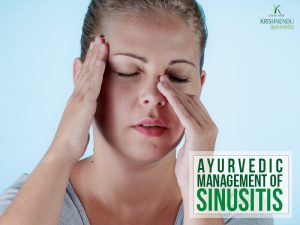



Ayurvedic Management Of Sinusitis
Sinusitis is the condition where the sinuses or the empty cavities within the facial bones are inflamed and blocked with mucus. It presents with headache, nasal congestion, discoloured nasal discharge, pain in the face, sore throat, etc. Causes that lead to sinus infection include common cold, allergic rhinitis, exposure to cold winds, regular consumption of cold foods, etc. Ayurveda refers to sinusitis as Pinas and regards the aggravation of Kapha dosha to be the cause. Aggrvated Kapha dosha vitiates the Prana Vata that is a sub type of Vata dosha which is present in the respiratory tract and Shleshaka Kapha that is a sub dosha of Kapha which governs moisture balance and lubrication. This imbalance of sub doshas results in a toxic sticky mucus that settles and clogs the sinus channels. Ayurvedic treatments for Sinusitis Nasyam – It is the therapeutic administration of medicines through nostrils. This detoxification procedure in Panchakarma is highly advised for relieving sinusitis. The therapy helps clear and lubricate the nasal passages, while also allowing the medicine to reach all parts of the head and neck to treat various conditions pertaining to the region. Dhoomapana – Inhaling medicated fumes is also considered beneficial for sinus congestion. Dhoomapana is also beneficial for preventing disorders occurring above the shoulders like rhinitis, tonsillitis, neck stiffness, etc. Vamana – In this process of medicated emesis which is a part of Panchakarma, toxins from the body is eliminated through vomiting. Vamana is recommended for expelling aggravated Kapha dosha and thus is therapeutic for diseases caused by Kapha vitiation. Jala Neti – Nasal cleansing with lukewarm water is an effective Yogic method to cure sinusitis, allergies, etc. Pranayama – Breathing techniques like Kapalbhati Pranayama, Bhastrika Pranayama, Anulom Vilom, Suryabhedi Pranayama, etc, are also considered beneficial for sinusitis. Natural home remedies for sinusitis Inhaling steam of eater boiled with tulsi leaves is helpful for acute sinusitis. Nasal steam inhalation using hot water with mint, eucalyptus oil or clove oil is also recommended. Also have a salt water gargle after it to clean the throat. Apply paste made with cinnamon powder and warm water on forehead and nose to remove congestion. Boil a glass of water with basil leaves, crushed pepper powder, sugar candy and ginger. When the mixture reduces to half, strain it and drink warm. Add 2 teaspoons of fenugreek seeds to 4 glasses of water and boil it until it reduces to half. Stain the mixture and drink warm. Have a teaspoon of fresh ginger juice mixed with a teaspoon of honey twice daily.
